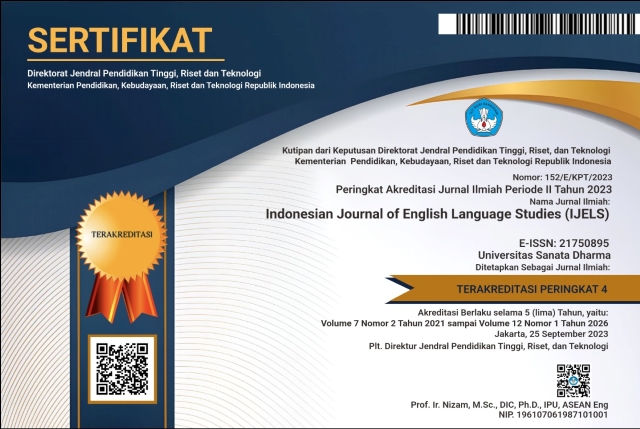The Use of Webpage in English Teaching
(1) Sanata Dharma University
(2) Sanata Dharma University
(3) Sanata Dharma University
(*) Corresponding Author
Abstract
There has been a change in the realm of education these days. Started with teachers as the center of learning back then, becoming students as the main key of learning, and this has led to an independent learning environment. Technology has been taking an important role of this change happening in the society, with no exception in the language education as well. Moreover, it is the fact that in English language, students are required to master four skills, namely speaking, listening, reading, and writing. There have been many ways of teaching those four skills to students, but unfortunately often those strategies do not meet students’ needs. Technology development, therefore, comes to provide new solutions to these issues that both teachers and students could grab the benefits of it. Thereupon in this paper, the authors try to provide insights as comprehensive as possible regarding with technology development, which is webpage, which can be used by teachers to assist the English teaching, especially in the sense of teaching reading and listening skills to students.
Keywords
Full Text:
PDFReferences
REFERENCES
Beatty, K. (2006). Teaching and researching computer-assisted language learning. London: Longman, Inc.
Boukadi, S. (2014). Critical approach to integrating ICT into second language learning. In R. Mahrooqi and S. Troudi (eds.) Using technology in foreign language teaching (pp. 83-105). Newcastle upon Tyne: Cambridge Scholars Publishing.
Byock, I. (2002). The meaning and value of death. Journal of Palliative Medicine, 5(2), 279-288.
Chapelle, C. A. (2003). Computer applications in second language acquisition: Foundation for teaching, testing, and research. Cambridge: Cambridge University Press.
Egbert, J.,Ci,C.C.,& Smith, E.H.(2007). Introduction: Foundations for teaching and learning. In E. Hanson-Smith, & J. Egbert (Eds), CALL environments: Research, practice, and critical issues (2nd ed., pp. 1-14). Teachers of English to speakers of Other Languages, Inc (TESOL).
Egbert, J., & Hanson-Smith, E. (1999). CALL environment: Research, practice, and critical issues. Alexandria: TESOL.
Ellis, R. (2008). The study of second language acquisition (2nd ed). Oxford: Oxford University Press.
Hadian, M. (2015). The use of song lyrics in teaching listening: A case study of junior high school grade 8 in Bandung). Journal of English and Education, 3(1), 96-105.
Hui-Fang, S. (2005). Email dialogue journaling: Attitudes and impact on l2 reading performance. Educational Studies, 31(2), 197-212.
Jack, W. X. (2013). The function of English songs to improve listening to college English as a second language (ESL) students.
Jacobs, G., & Gallo, P. (2002). Reading alone together: Enhancing extensive reading via Student-student cooperation. Reading Online, 5(6).
Jarvis, H. and Szymczyk, M. (2010). Student views on learning grammar with web and book-based materials. English Language Teaching Journal, 61(1), 32-44.
Johnston, B. (2007). Theory and Research: Audience, Language Use, and Language Learning. In E. Hanson-Smith, & J. Egbert (Eds.), CALL environments: Research, practice, and critical issues (2nd ed., pp.61-69). Teachers of English to Speakers of Other Language,Inc (TESOL).
Levy, M. (1997). CALL: Context and conceptualization. Oxford: Oxford University Press
Listiyaningsih, T. (2017). The influence of listening English songs to improve listening skills in listening class. Academica Journal of Multidisciplinary Studies, 1(1), 36-49
Mahrooqi, R and Troudi, S. (2014). Introduction: Using technology in foreign language teaching. In R. Mahrooqi and S. Troudi (Eds.) Using technology in foreign language teaching (pp. 1-7). Cambridge Scholars Publishing.
Nunan, D. (2004) Task-based language teaching. New York: McGraw-Hill Companies.
Nunan, D. (1989). Understanding the language classroom. London: Prentice Hall.
Setiawan E. (2016). The use of Hot Potatoes for teaching vocabulary at the eleventh grade of SMA Bodhisattva. The Fourth International Conference on Education and Language (4th ICEL) pp. 232-240). Bandar Lampung: Faculty of Teacher Training Education (FKIP) English Education Program of Bandar Lampung University.
Sibero, Alexander F.K . 2013. Web programming power pack. Yogyakarta : Mediakom.
Shyamlee, S. and Phil,M. (2012) Use of technology in English language teaching and learning: An analysis. International Conference on Language, Medias and Cultre IPEDR Vol. 33.
Thomas, M., Reinders, H. and Warschauer, M. (2012). Contemporary computer-assisted language learning: The role of digital media and incremental change. In M. Thomas, H. Reinders and M. Warschauer, Contemporary computer-assisted language learning. Bloomsbury Publishing PLC. 21-31
DOI: https://doi.org/10.24071/ijels.v5i2.2865
Refbacks
- There are currently no refbacks.

This work is licensed under a Creative Commons Attribution-ShareAlike 4.0 International License.
IJELS Journal Sinta 4 Certificate (S4 = Level 4)
We would like to inform you that Indonesian Journal of English Language Studies (IJELS) has been nationally accredited Sinta 4 by the Ministry of Education, Culture, Research and Technology of the Republic of Indonesia based on the decree No. Surat Keputusan 152/E/KPT/2023. Validity for 5 years: Vol 7 No 2, 2021 till Vol 12 No 1, 2026

This work is licensed under CC BY-SA.
Creative Commons Attribution-ShareAlike 4.0 International License
IJELS e-ISSN 2715-0895; IJELS p-ISSN 2442-790X
Indonesian Journal of English Language Studies (IJELS) is published twice a year, namely in March and September, by the English Language Studies (ELS) of the Graduate Program of Sanata Dharma University, Yogyakarta, Indonesia.


 IJELS p-ISSN:
IJELS p-ISSN: 









